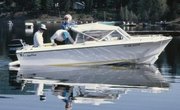The power trim switch on a boat raises and lowers the engine. It positions the boats engine for optimum performance while underway. The power trim switch also raises the engine when transporting the boat so the prop clears the ground. The power trim switch usually is located on the throttle but may be located on the engine and/or the bow of the boat. Each of these switches is wired the same. These instructions refer to the switch at the throttle, but can be used on any switch.
Items you will need
Screwdriver
Needle-nose pliers
Sandpaper
Multimeter
Step 1
Remove the screws in the throttle handle and remove the cover to access the trim switch. Note the position of wires before removing them from switch terminals. The middle wire is red and furnishes 12 volts to the switch at all times. The blue wire applies 12 volts to raise the engine. The green wire applies 12 volts to lower the engine. When the switch is pressed, the respective contact inside touches the red contact to receive 12 volts to function.
Step 2
Remove the wires from the switch terminals with needle-nose pliers. This will isolate the switch from the circuit. Examine the switch terminals for corrosion, which could affect your readings. Remove any corrosion found using sandpaper.
Step 3
Set the multimeter to the continuity check position. Troubleshoot the up position of the switch by touching the red lead to the terminal to which the red wire was connected. Touch the black lead to the terminal to which the blue wire was connected. Press the button labeled up and listen for the tone from the multimeter. If you hear a tone, the up position of the trim switch is good. If you don not hear a tone, it is bad.
Step 4
Troubleshoot the down position of the trim switch by maintaining contact between the red lead and the terminal to which the red wire was connected. Touch the black lead to the terminal to which the green wire was connected. Press the button labeled down and listen for a tone from multimeter. If you hear a tone while button is pressed, the down position of the trim switch is good. If you do not hear a tone, it is bad.
References
Writer Bio
Indiana-based Ken McBroom has been writing since 2005. McBroom has written numerous articles on the outdoors. He got his start as a staff writer for "Water and Woods" magazine and has since had several articles about the outdoors published in "Midwest Outdoors," "Tri-State Outdoors" and "The Sportsman's Guide." He attended Colorado Aero Tech and holds an aircraft mechanic certificate.



